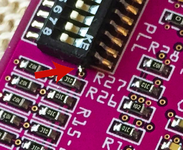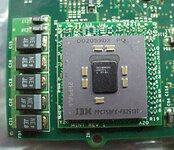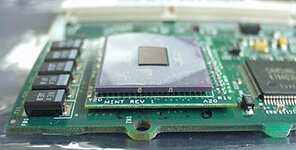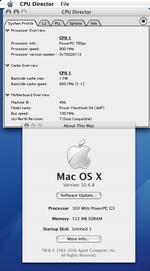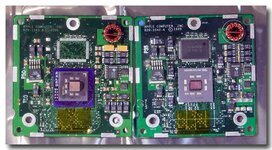To begin with: this post was made possible by joevt, who figured out the software. Thank you joevt!
So that ebay seller looks like a good source for 750G chips. The listing has been active for years and it shows hundreds have been sold. What are people doing with them?
I was curious about the 750G, as these chips are actually available and with the built-in 1MB of L2 cache it's basically the top of the line for the G3 series in the same way that the 7448 is for the G4. So I placed an order and stuck one on the CPU board out of an AGP.
It's difficult to find good comparisons between the 750G and its predecessors. There are geekbench results posted for different computers like the iBook with the 750F, or 750C, or PowerMac or PowerBook with G3 upgrades (including the 750G). However as is typical with geekbench, the numbers are highly variable (i.e. not very useful as a benchmark). Although one thing is clear, a G3 of any variety is no match for later G4 chips. Because of this and being a 3.3v chip, I think it's better suited to the 603, 604, and G3 series of computers anyway. The 7400/7410 chips are the last 3.3v G4, so comparing to those makes more sense. I had previously tested a 750S with external L2 cache in an AGP, and it was significantly slower than a 7400 G4 at the same clock. Could the 750G do better?
The chip I tried did 1.1GHz with ease, and I compared it to a 650MHz 7410 with 2MB of L2 cache (a high end 3.3v G4). In most cases the 750G was clearly faster. In a few cases where altivec was used by the software, the G4 was faster. Also, the memory bandwidth on the 750G was *much* lower. This seems abnormal, but any benchmark results I've seen for any G3 under OS X were similar. Even a G4 chip in 60x bus mode has much higher memory speed. This could be some limitation of OS X? Fortunately the nice built-in L2 cache helps a lot. With it disabled, the chip is between 2x and 8x slower. On something with a slower bus, say 50Mhz, the cache would be even more important.
Hopefully this result will encourage other experimenters out there. There are still some mysteries about the aftermarket upgrades that used these chips. If anyone has a 750G (or even a 750F) and would be willing to share data, it would be nice collect some information about these CPUs in this thread. For example, what happened with this?:
View attachment 76641
View attachment 76643

